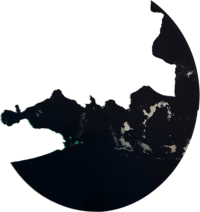Place is more than geography. It is not merely a point on a map, but a confluence of material conditions, sensory impressions, and lived experience. When we speak of “place,” we speak of something inhabited — physically, emotionally, and temporally. To be in a place is to be entangled in its specific textures, temperatures, light, air, and atmosphere. Presence, then, is the act of being with place — not as an observer standing apart, but as a participant shaped by it.
In modern life, presence is often fractured. We move quickly, absorb information remotely, and experience landscapes through screens. But presence is not just physical proximity; it is attentiveness. It requires the body, the senses, and a quiet kind of surrender. To be present in a place is to allow oneself to be affected — by wind and weather, by the rhythm of time, by what can be felt but not always understood.
Artists have long turned to place as both subject and collaborator. In certain practices, place becomes medium. Wind bends a tree, light fades a pigment, salt corrodes metal. The resulting forms are not imposed, but revealed — traces left by presence over time. Such works are not about landscape in a representational sense, but about what it feels like to be there. They are residues of encounter.
Presence also activates memory and emotion. A place is never neutral. It carries history — personal, political, geological — and this history echoes through the body. A person entering a space carries their own interior weather. Thus, each act of presence is both an exposure to the external and a revelation of the internal. To be present is to let the world in — and to become visible to it in return.
In contemporary art, especially within environmental and site-responsive practices, the tension between place and presence has become increasingly urgent. How do we inhabit place without dominating it? How can presence resist extractive attention and instead foster reciprocity? These are not only artistic questions but ethical ones.
To create from presence is to slow down, to listen, and to let go of certainty. The artist becomes a kind of seismograph — registering not only physical tremors but emotional and energetic shifts. The resulting work may not explain place, but it transmits it. It allows the viewer or listener to momentarily step into that presence, to feel the air, the pressure, the stillness — and perhaps recognize something of their own presence in return.
-Markus Kager + AI
April 8, 2025
